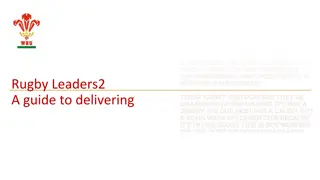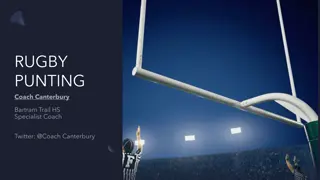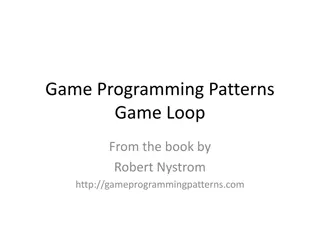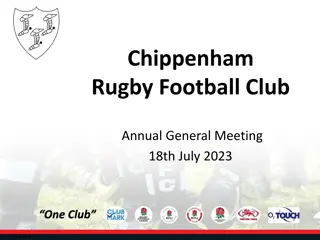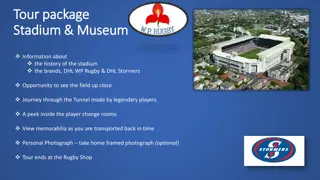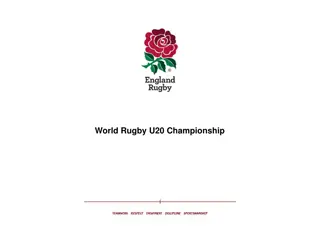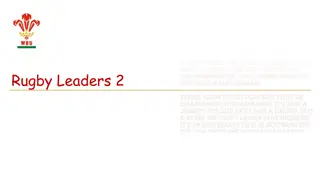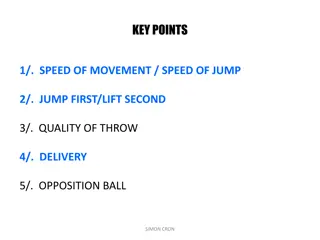Introduction to Rugby: A Simple but Complex Game Explained
Explore the world of rugby with insights into the game's history, rules, team composition, and the art of passing. Learn about the dynamics of rugby matches and how the sport has evolved into one of the most popular games globally. Experience the thrill of playing rugby through engaging visuals and discover the unique aspects that make rugby both simple and complex. Get ready to dive into the action-packed world of rugby!
Download Presentation

Please find below an Image/Link to download the presentation.
The content on the website is provided AS IS for your information and personal use only. It may not be sold, licensed, or shared on other websites without obtaining consent from the author.If you encounter any issues during the download, it is possible that the publisher has removed the file from their server.
You are allowed to download the files provided on this website for personal or commercial use, subject to the condition that they are used lawfully. All files are the property of their respective owners.
The content on the website is provided AS IS for your information and personal use only. It may not be sold, licensed, or shared on other websites without obtaining consent from the author.
E N D
Presentation Transcript
http://www.vyra.org/wp-content/themes/vyra-default/images/logo.gifhttp://www.vyra.org/wp-content/themes/vyra-default/images/logo.gif Introduction to Rugby
http://www.vyra.org/wp-content/themes/vyra-default/images/logo.gifhttp://www.vyra.org/wp-content/themes/vyra-default/images/logo.gif Rugby a Simple but Complex Game Rugby a Simple but Complex Game
http://www.vyra.org/wp-content/themes/vyra-default/images/logo.gifhttp://www.vyra.org/wp-content/themes/vyra-default/images/logo.gif I Play Rugby I Play Rugby https://www.youtube.com/watch?v=K3j9taoTd0E
http://www.vyra.org/wp-content/themes/vyra-default/images/logo.gifhttp://www.vyra.org/wp-content/themes/vyra-default/images/logo.gif Rugby started in England in 1823 Present day one of the World s most popular sports Returns to the Olympics in 2016 (Both Women and Men High School Rugby Governed by USA Rugby
http://www.vyra.org/wp-content/themes/vyra-default/images/logo.gifhttp://www.vyra.org/wp-content/themes/vyra-default/images/logo.gif
http://www.vyra.org/wp-content/themes/vyra-default/images/logo.gifhttp://www.vyra.org/wp-content/themes/vyra-default/images/logo.gif Passing Passing Passing backward only Can pass backwards multiple times Forward pass results in loss of possession One forward pass provided from behind the line of scrimmage per play Can pass backwards multiple times
http://www.vyra.org/wp-content/themes/vyra-default/images/logo.gifhttp://www.vyra.org/wp-content/themes/vyra-default/images/logo.gif Team Composition Team Composition All players on the field attack and defend 8 forwards & 7 backs on field at the same time 7 substitutions can be made, but substituted player can not return unless for a bleeding injury Platoon system with specialized offensive, defensive, and special teams players One group of 11 on the field at a time Substitutes can return to the game at any time.
http://www.vyra.org/wp-content/themes/vyra-default/images/logo.gifhttp://www.vyra.org/wp-content/themes/vyra-default/images/logo.gif Rugby Positions 8 Forwards Hooker 2; Locks 4,5; Flankers 6,7; Number 8) Rugby Positions 8 Forwards (Props 1,3; 7 Backs Half 10; Centres 12,13; Wings 11,14; Fullback 15) 7 Backs (Scrum Half 9; Fly
http://www.vyra.org/wp-content/themes/vyra-default/images/logo.gifhttp://www.vyra.org/wp-content/themes/vyra-default/images/logo.gif Game Duration Game Duration 2 halves of 40 minutes High School plays 30 minute halves Clock only stopped for substitutions & injuries Game continues at end of a half until ball is dead, not when tackled 4 quarters of 15 minutes Clock stops for multiple reasons during the game Play continues at end of a half until player is tackled or ball is dead
http://www.vyra.org/wp-content/themes/vyra-default/images/logo.gifhttp://www.vyra.org/wp-content/themes/vyra-default/images/logo.gif Game Play Game Play Short plays Carry or pass the ball over the opponent s goal line for a 6 point Touchdown Play ends if player is tackled or ruled out of bounds Longer & fluid passages of play Carry the ball over the opponent s goal line for a 5 point Try When player is tackled the ball must be released. Any player arriving at the scene can pick-up the ball & run
http://www.vyra.org/wp-content/themes/vyra-default/images/logo.gifhttp://www.vyra.org/wp-content/themes/vyra-default/images/logo.gif Ruck A ruck or more opposing players arrive at the tackled player at the same time. The opposing players push each other to allow their teammates to pick-up the ball and run Ruck: : ruck is formed when two
http://www.vyra.org/wp-content/themes/vyra-default/images/logo.gifhttp://www.vyra.org/wp-content/themes/vyra-default/images/logo.gif Kicking Kicking Tactical and Defensive Ball can be recovered by kicking team Can kick the ball at the goal anytime during play (Drop goal) Team kicking gives up possession unless receiver muffs ball Field goals only from behind line of scrimmage
http://www.vyra.org/wp-content/themes/vyra-default/images/logo.gifhttp://www.vyra.org/wp-content/themes/vyra-default/images/logo.gif Advancing the Ball Advancing the Ball By running Ball carrier passes backwards to a teammate before being tackle to permit this player to run with ball Kicking ball forward and attempting to recover it By running Handoffs and laterals Passing forward once per play and only from behind the line of scrimmage
http://www.vyra.org/wp-content/themes/vyra-default/images/logo.gifhttp://www.vyra.org/wp-content/themes/vyra-default/images/logo.gif Tackles and Blocks Tackles and Blocks Tackle player with ball Play is dead Offensive team retains possession Can simply knock player to the ground or grab jersey Can block in front of teammate Tackle player with ball Ball is still in play Either team can take possession No tackling above the shoulders Wraps arms around player & take to ground Blocking prohibited
http://www.vyra.org/wp-content/themes/vyra-default/images/logo.gifhttp://www.vyra.org/wp-content/themes/vyra-default/images/logo.gif Scoring Scoring Try 5 points, must touchdown ball to score try Conversion Kick 2pts; taken from position in line with try location Drop goal 3 points No points for tackling opponent in try zone Touchdown 6 points Extra Point Kick 1 pt or 2 pt conversion Field Goal 3 points Safety 2 points
http://www.vyra.org/wp-content/themes/vyra-default/images/logo.gifhttp://www.vyra.org/wp-content/themes/vyra-default/images/logo.gif Attire Attire Modest soft padding on head, shoulders, and collarbone Jersey, rugby shorts, cleats, & socks Mouthguard No metal or hard plastic Padded plastic helmet, shoulder pads, hip & knee pads Face mask Mouthguard
http://www.vyra.org/wp-content/themes/vyra-default/images/logo.gifhttp://www.vyra.org/wp-content/themes/vyra-default/images/logo.gif Collisions Collisions California Study found that the impact force in football was 3 times greater than in rugby (4800 pounds to 1600 pounds). California Study found that the impact force in football was 3 times greater than in rugby (4800 pounds to 1600 pounds). Tackles must show an attempt to wrap-up player Wrestle player to the ground Not allowed to tackle in the air Contact time is longer Tend to cause greater injury Blind sided possible Players moving at a greater speed Impact knock-downs
http://www.vyra.org/wp-content/themes/vyra-default/images/logo.gifhttp://www.vyra.org/wp-content/themes/vyra-default/images/logo.gif Safety Safety Injuries per 1,000 athlete exposures (games and practices combined) NCAA football 54.8 injuries (Includes both Spring and Fall Football) Collegiate Women s Rugby 11.2 injuries Collegiate Men s Rugby 22.2 injuries NCAA Women s Soccer 23.7 injuries NCAA Men s Soccer 26.8 injuries Concussion Rate in Women s Soccer 9.2% of injuries; 7.4% in Football; 5.5% in Men s Soccer; 2.2% Men s Rugby; 1.6% Women s Rugby *NCAA injury rates are from the NCAA website and the Rugby injury rates are from British Journal of Sports Medicine article written by Dr. Lyle Micheli Collegiate Rugby Union Injury Patterns in New England
http://www.vyra.org/wp-content/themes/vyra-default/images/logo.gifhttp://www.vyra.org/wp-content/themes/vyra-default/images/logo.gif Scrum A scrum restarting play after a minor infringement. Involves 8 players from each team, commonly awarded when the ball is knocked or passed forward. Scrum: : scrum is a means of
http://www.vyra.org/wp-content/themes/vyra-default/images/logo.gifhttp://www.vyra.org/wp-content/themes/vyra-default/images/logo.gif Maul A maul take the ball into play and keep it off the ground during contact. The person holding the ball cannot run because three or more players on his team and at least one player from the opposing team surround and hold him. The idea is to move the entire formation towards the try line and then get the ball out in order to score Maul: : maul is when you
http://www.vyra.org/wp-content/themes/vyra-default/images/logo.gifhttp://www.vyra.org/wp-content/themes/vyra-default/images/logo.gif Lineout A lineout is the means by which the ball is put back into play after it has gone into touch (over the sidelines) Lineout: :
http://www.vyra.org/wp-content/themes/vyra-default/images/logo.gifhttp://www.vyra.org/wp-content/themes/vyra-default/images/logo.gif Why did the whistle blow? Why did the whistle blow? Offside Offside: : Ball establishes offside line, which is continually moving Players are not permitted to participate in play if on the opposing team s side of the ball Simply being offside is not a penalty, must attempt to participate from an offside position to be offside
http://www.vyra.org/wp-content/themes/vyra-default/images/logo.gifhttp://www.vyra.org/wp-content/themes/vyra-default/images/logo.gif Why did the whistle blow? Why did the whistle blow? Knock Knock- -on on: : When a player mishandles the ball; drops or allows ball to rebound off a hand or arm and the ball travels forward Punishable by a scrum to the opposition
http://www.vyra.org/wp-content/themes/vyra-default/images/logo.gifhttp://www.vyra.org/wp-content/themes/vyra-default/images/logo.gif Why did the whistle blow? Why did the whistle blow? Advantage Advantage: : When an infringement occurs, if the referee thinks the non-offending team might benefit by continuing play How much territory or opportunity is needed before advantage is gained depends on the nature of the offense Applies to minor infringements or penalties If no advantage occurs, the referee blows whistle and brings play back to the place of the infringement
http://www.vyra.org/wp-content/themes/vyra-default/images/logo.gifhttp://www.vyra.org/wp-content/themes/vyra-default/images/logo.gif Questions ? Questions ?





